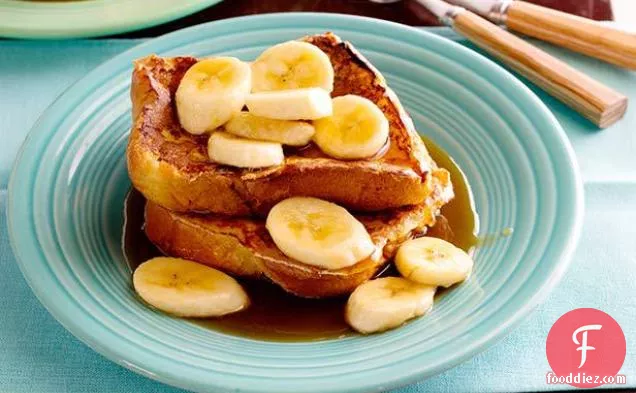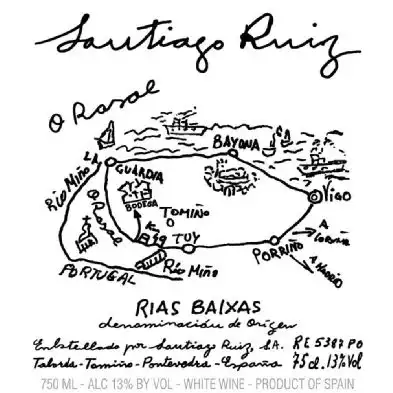Texas French Toast Bananas Foster

You can never have too many dessert recipes, so give Texas French Toast Bananas Foster a try. This recipe covers 10% of your daily requirements of vitamins and minerals. This recipe serves 6. One serving contains 871 calories, 8g of protein, and 45g of fat. If you have milk, rum, brown sugar, and a few other ingredients on hand, you can make it. This recipe is typical of Creole cuisine. From preparation to the plate, this recipe takes about 40 minutes.
Instructions
2
Batter: In a large bowl, combine all of the ingredients until a smooth batter is formed.
Equipment you will use![Bowl]() Bowl
Bowl
3
Sauce: In a saucepan over medium-high heat, melt the butter, then add the brown sugar. Stir continuously until the sugar has dissolved.
Ingredients you will need![Brown Sugar]() Brown Sugar
Brown Sugar![Butter]() Butter
Butter![Sauce]() Sauce
Sauce![Sugar]() Sugar
Sugar
Equipment you will use![Sauce Pan]() Sauce Pan
Sauce Pan
4
Add the cinnamon and orange juice and bring to a simmer.
Ingredients you will need![Orange Juice]() Orange Juice
Orange Juice![Cinnamon]() Cinnamon
Cinnamon
5
Remove the pan from the heat, pour in the rum and creme de banana, if using, then return the pan to the heat.
Ingredients you will need![Banana]() Banana
Banana![Rum]() Rum
Rum
Equipment you will use![Frying Pan]() Frying Pan
Frying Pan
6
Brush down the sides of the pan with water using a pastry brush.
Ingredients you will need![Water]() Water
Water
Equipment you will use![Pastry Brush]() Pastry Brush
Pastry Brush![Frying Pan]() Frying Pan
Frying Pan
8
In a small saute pan, add 1/4 cup of the caramel sauce and the bananas.
Ingredients you will need![Caramel Sauce]() Caramel Sauce
Caramel Sauce![Banana]() Banana
Banana
Equipment you will use![Frying Pan]() Frying Pan
Frying Pan
10
Toast: Preheat a griddle or a nonstick pan over high heat. Dip the bread slices into the batter, then put them on the griddle, turning over after 2 minutes. To each serving plate, add 1/4 cup of the caramel sauce and top with the French toast. Spoon the bananas, over the toast and drizzle with some of the caramel sauce.
Ingredients you will need![Caramel Sauce]() Caramel Sauce
Caramel Sauce![Banana]() Banana
Banana![Bread]() Bread
Bread![Toast]() Toast
Toast![Dip]() Dip
Dip
Equipment you will use![Frying Pan]() Frying Pan
Frying Pan
Ingredients
1Tbsp![creme de banana liqueur, optional]() creme de banana liqueur, optional3
creme de banana liqueur, optional3![bananas, peeled and sliced]() bananas, peeled and sliced473milliliters
bananas, peeled and sliced473milliliters![packed brown sugar]() packed brown sugar59milliliters
packed brown sugar59milliliters![dark rum]() dark rum3
dark rum3![eggs]() eggs0teaspoons
eggs0teaspoons![ground cinnamon]() ground cinnamon0teaspoons
ground cinnamon0teaspoons![ground cinnamon]() ground cinnamon79milliliters
ground cinnamon79milliliters![heavy cream]() heavy cream118milliliters
heavy cream118milliliters![orange juice]() orange juice0teaspoons
orange juice0teaspoons![orange-flavored liqueur (recommended: Grand Marnier)]() orange-flavored liqueur (recommended: Grand Marnier)0teaspoons
orange-flavored liqueur (recommended: Grand Marnier)0teaspoons![sea salt]() sea salt6
sea salt6![thick bread slices, preferably French toast bread (brioche) or Texas toast]() thick bread slices, preferably French toast bread (brioche) or Texas toast237milliliters
thick bread slices, preferably French toast bread (brioche) or Texas toast237milliliters![unsalted butter]() unsalted butter0teaspoons
unsalted butter0teaspoons![pure vanilla extract]() pure vanilla extract79milliliters
pure vanilla extract79milliliters![milk, preferably whole]() milk, preferably whole
milk, preferably whole
 creme de banana liqueur, optional3
creme de banana liqueur, optional3 bananas, peeled and sliced473milliliters
bananas, peeled and sliced473milliliters packed brown sugar59milliliters
packed brown sugar59milliliters dark rum3
dark rum3 eggs0teaspoons
eggs0teaspoons ground cinnamon0teaspoons
ground cinnamon0teaspoons ground cinnamon79milliliters
ground cinnamon79milliliters heavy cream118milliliters
heavy cream118milliliters orange juice0teaspoons
orange juice0teaspoons orange-flavored liqueur (recommended: Grand Marnier)0teaspoons
orange-flavored liqueur (recommended: Grand Marnier)0teaspoons sea salt6
sea salt6 thick bread slices, preferably French toast bread (brioche) or Texas toast237milliliters
thick bread slices, preferably French toast bread (brioche) or Texas toast237milliliters unsalted butter0teaspoons
unsalted butter0teaspoons pure vanilla extract79milliliters
pure vanilla extract79milliliters milk, preferably whole
milk, preferably wholeRecommended wine: Albarino, Rose Wine, Sauvignon Blanc
Cajun can be paired with Albarino, rosé Wine, and Sauvignon Blanc. These low-tannin, lower alcohol wines will complement the heat in spicy cajun dishes, instead of making your mouth burn more. The Santiago Ruiz Albarino Blend with a 4.6 out of 5 star rating seems like a good match. It costs about 23 dollars per bottle.

Santiago Ruiz Albarino Blend
Clear and bright yellow. Intense and complex nose showcasing aromas of fruit (apple, pear, apricot), herbs (lemon verbena, aniseed) and mineral notes. Full bodied, its fruity complexity returns combined with wet-stone minerality on the palate prior to a long and crisp finish. The combination of five native grape varieties to Rias Baixas makes this a wine with a uniquely distinct character.DifficultyHard
Ready In40 m.
Servings6
Health Score2
Related recipes
Cherry Tomato Corn Salad
Family Friendly Corn Salad
Mexican Corn Salad
Quinoa Corn Salad
Magazine

Your Inner Chef with Taylor Swift's Top 3 Recipes from Her Beloved NYC Hangout

20 Mouthwatering Recipes You Need to Try Today!

Master the Art of Making Perfect Pancakes with This Foolproof Recipe

The Science Behind Red Wine: Its Surprising Health Benefits and Potential Risks

12 Wine Cocktails for a Sophisticated Twist

Sip, Swirl, and Celebrate: Toasting to National Wine Day on May 25th

National Drink Wine Day on February 18

Celebrating Souffle Day with Delectable Delights

Indulge in the Delightful Flavor of Oyster Soup on Its Special Day!

Celebrating World Nutella Day

How to Peel, Chop, and Grate Ginger

How to Make Lasagne

How to Eat Grapefruit to Lose Weight

How to Cut Kiwi

How to Make Porridge with Water

How to Make Porridge with Coconut Milk

How to Make Porridge in the Microwave

How to Make Pancakes

How to Make a Romantic Dinner




